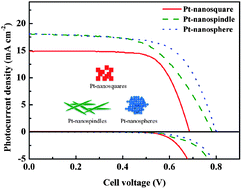A film of platinum nanostructure crystals is synthesized for the counter electrode (CE) of a dye-sensitized solar cell (DSSC) via an approach of water-in-oil microemulsions in the presence of an amphiphilic polymer, poly(oxyethylene)-segmented imide (POEM). Phase diagrams are constructed in mapping the compositions of the microemulsions to guide the synthesis of platinum nanostructure crystals. The conventional cationic surfactant, cetylmethyl ammonium bromide (CTAB), and anionic surfactant, docusate sodium salt (AOT), are compared with the newly developed POEM for preparing the emulsions. Transmission electron microscopic images reveal that the synthesized Pt nanostructure crystals have diversified morphologies, including nanospindle, nanosquare and nanosphere in correlation with the surfactants of CTAB, AOT, and POEM, respectively. X-ray diffraction patterns of the three Pt crystals indicates the presence of (111), (200) and (220) lattice planes of Pt. The Pt with different morphologies and structures are proved to be influential for catalytic ability when using them as Pt CEs in DSSCs. The DSSC with the CE containing the film of Pt nanospheres demonstrates a significantly improved power conversion efficiency of 9.34%, compared to 7.20% and 8.17% for the corresponding Pt nanosquare and Pt nanospindle films. Fourier transform spectroscopy (FTIR), electrochemical impedance spectroscopy (EIS), and cyclic voltammetry (CV) are also used to substantiate the explanation for the DSSC performance.

